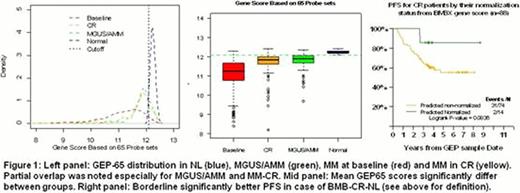Abstract
Abstract 198
GEP of purified plasma cells (PC) provides superb risk discrimination for PFS and overall survival (OS). It is well established that MM engages the BM micro-environment (ME) and subjugates it toward its survival and progression. International Myeloma Working Group- and flow-based CR have been linked to PFS and OS, but do not provide guidance vis-à-vis the duration of post-transplant consolidation and maintenance therapy. We reasoned that ME may still be altered in flow-CR as it may remain MM-impregnated long after CR is established; conversely, ME normalization may happen much earlier. In a first step, 20 BMB-NL were compared with 331 untreated patients with MM (BMB-MM), leading to the discovery of a 65 gene score (GEP-65), which was then applied to 83 patients with MGUS/asymptomatic multiple myeloma (AMM) and 88 MM patients in CR. GEP-65 risk scores were similar in BMB-CR and BMB-MGUS-AMM contrasting with significantly lower values for BMB-MM. Next we examined PFS for CR patients according to whether BMB-CR signature normalized (BMB-CR-NL, n=14) or failed to normalize (BMB-CR-MM, n=74). A borderline significantly superior PFS was observed in the former group suffering 2 events versus 31 in the remainder (p=0.08). We conclude that (1) BMB-MM differs markedly from BMB-NL, (2) BMB-CR resembles BMB-MGUS-AMM, and (3) BMB-CR-NL can be distinguished from BMB-CR-MM resulting in PFS differences. Availability of several hundred BMB-CR samples and nearly 100 BMB-NL will have been evaluated at the time of the meeting to address the following: (a) can these results be validated, (b) what is the time course of BMB-CR-NL and pattern to BMB-CR-MM and BMB-MM, (c) are there MM GEP molecular subgroup- and risk-dependent differences.
Dhodapkar:Celgene: Research Funding; KHK: Research Funding.
Author notes
Asterisk with author names denotes non-ASH members.


This feature is available to Subscribers Only
Sign In or Create an Account Close Modal